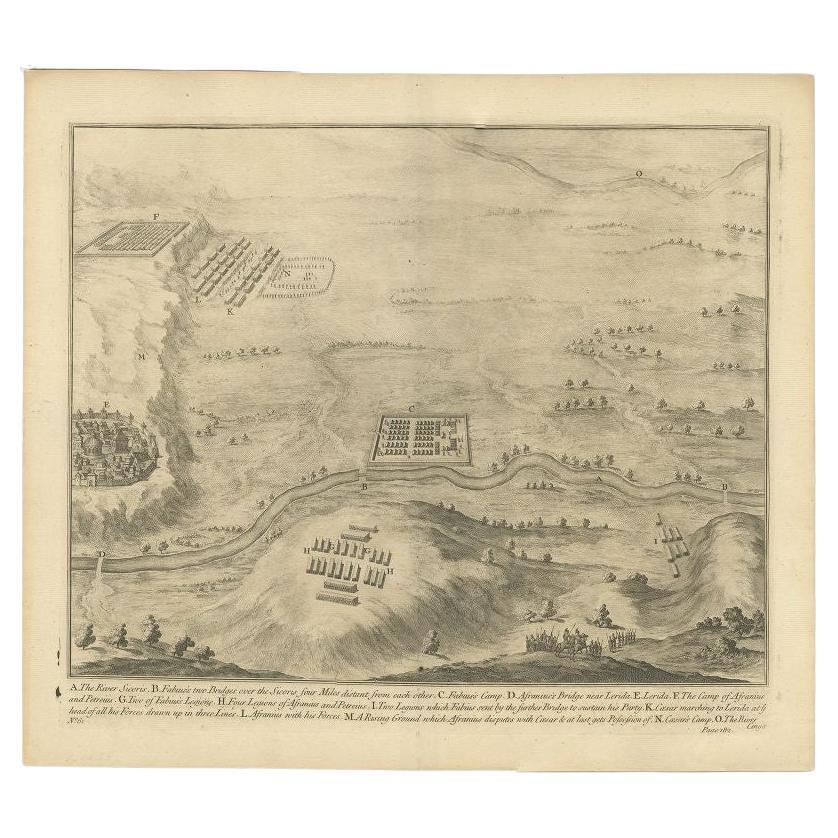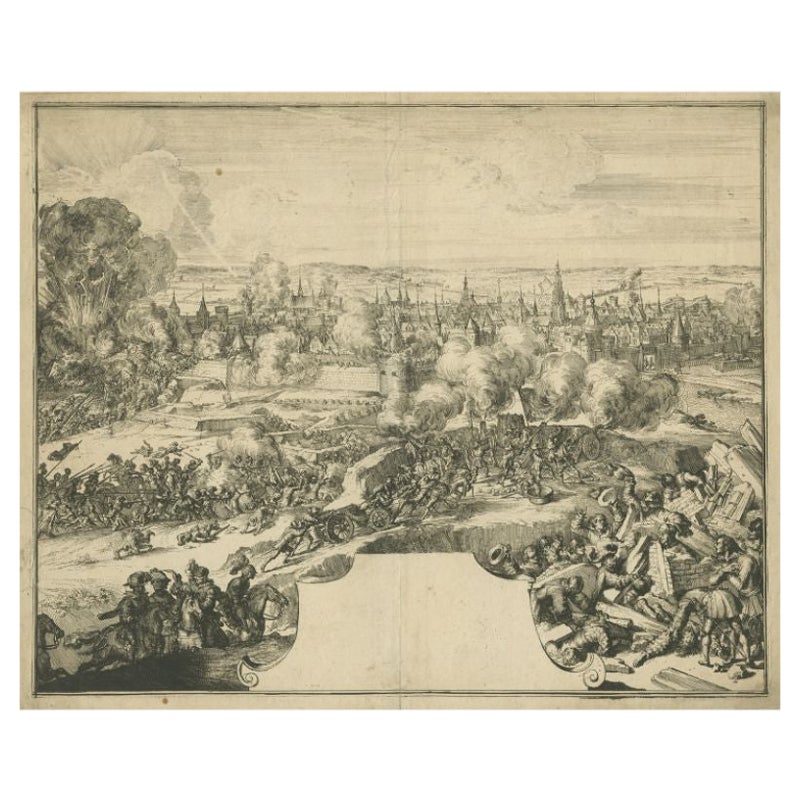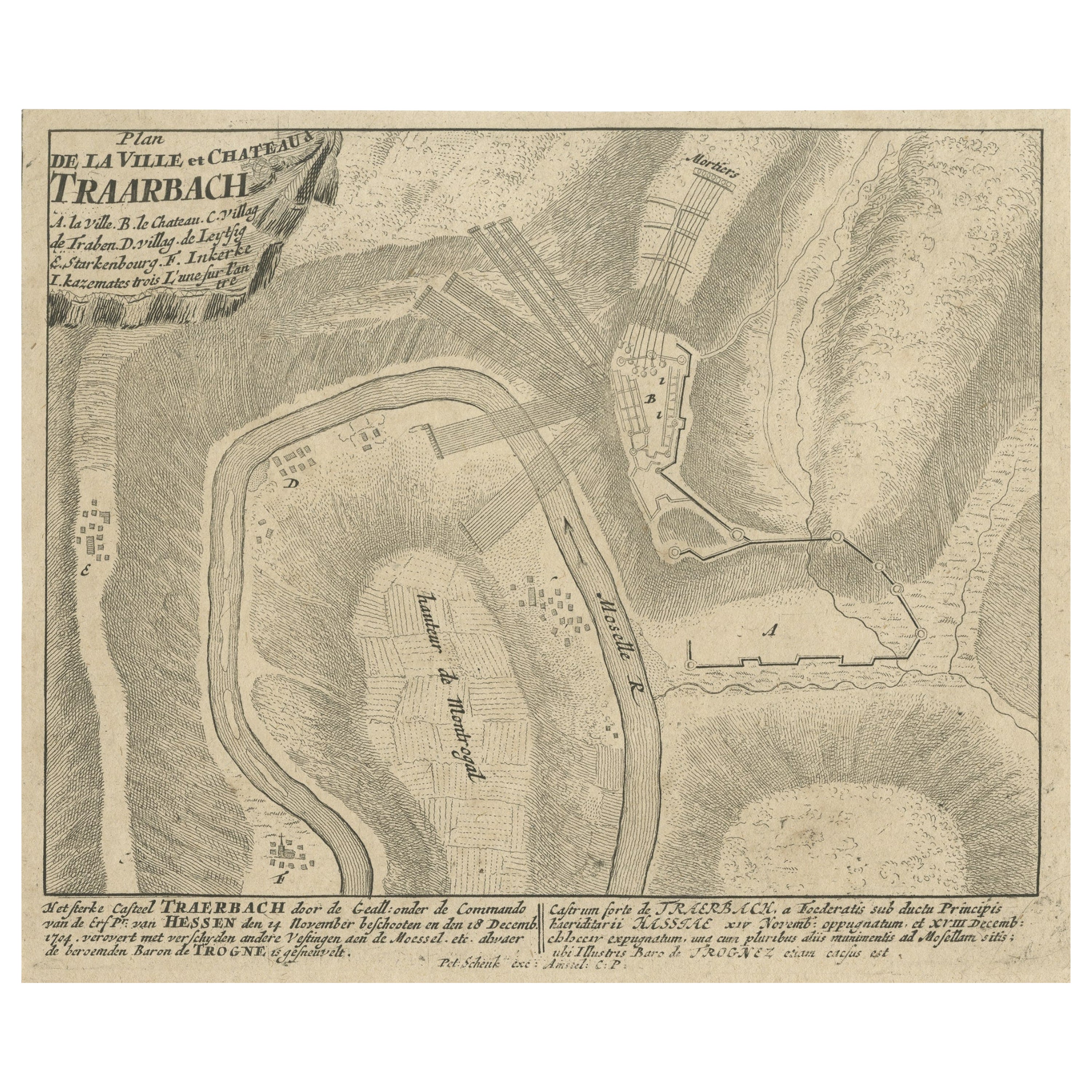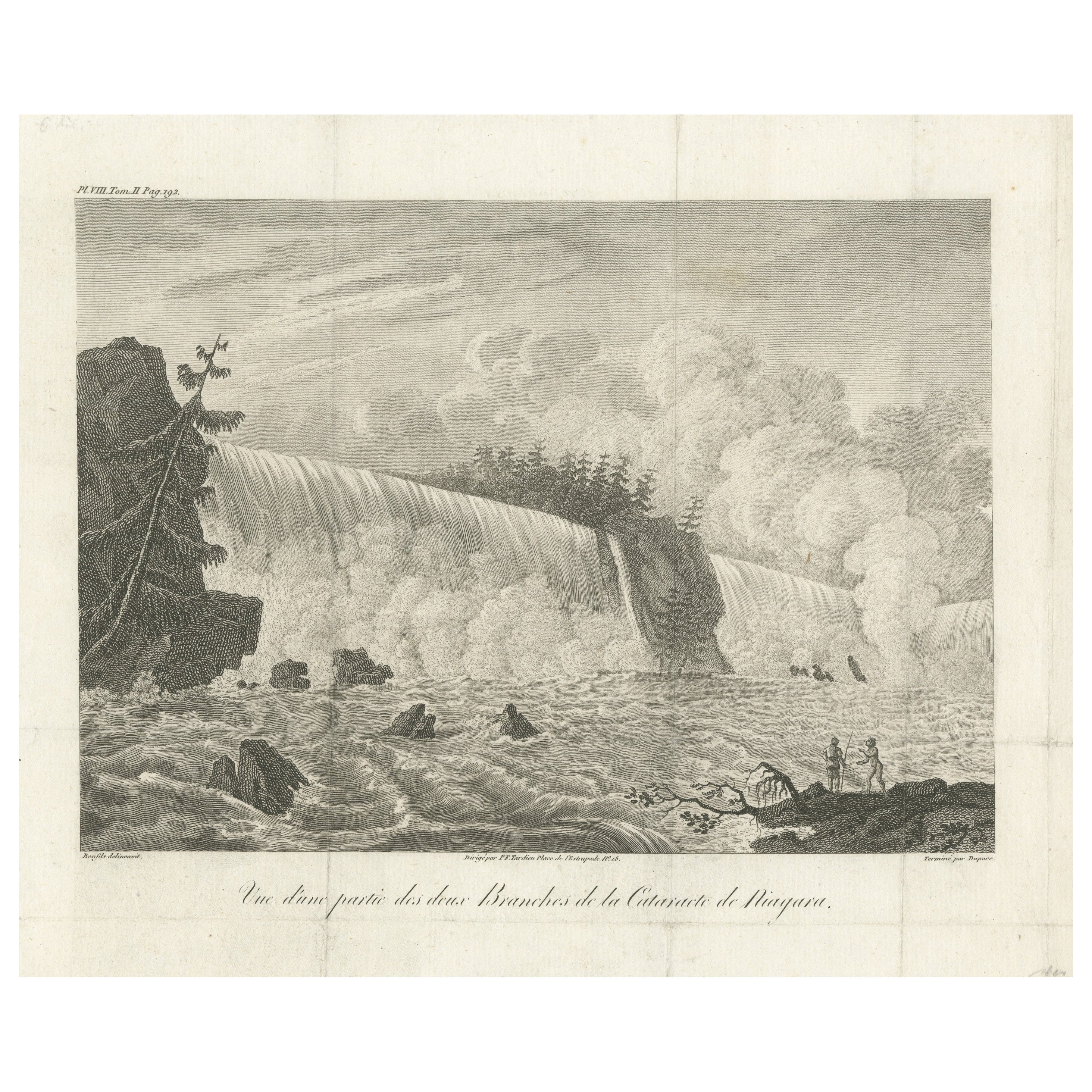Items Similar to Rare Engraving of a Famous Battle Near Ushant Between the French and British
Want more images or videos?
Request additional images or videos from the seller
1 of 6
Rare Engraving of a Famous Battle Near Ushant Between the French and British
About the Item
Antique print titled 'Der ungluckliche Zufall der beeden Frazösischen Kriegs (..) - Etat malheureux de Quebeck et de la Surveillante (..)'. An engraving of a painting by Richard Paton of the three and a half hour long naval battle of 6 October 1779 which was fought off Ushant between HMS Quebec, under the command of Captain George Farmer, and the Surveillante, under the command of Captain Couédic de Kergoaler. The Quebec caught fire and exploded, and the British crew were rescued by the French. Captain George Farmer (b.1732) died in the battle. American War of Independence (1775-83). This is an optical print, also called 'vue optique' or 'vue d'optique', which were made to be viewed through a Zograscope, or other devices of convex lens and mirrors, all of which produced an optical illusion of depth. Published circa 1780.
- Dimensions:Height: 15.16 in (38.5 cm)Width: 19.1 in (48.5 cm)Depth: 0.02 in (0.5 mm)
- Materials and Techniques:
- Period:
- Date of Manufacture:circa 1780
- Condition:Wear consistent with age and use. Age-related toning. Dutch handwriting below titles. Shows some wear and foxing, mainly in margins. Blank verso. Please study images carefully.
- Seller Location:Langweer, NL
- Reference Number:
About the Seller
5.0
Platinum Seller
These expertly vetted sellers are 1stDibs' most experienced sellers and are rated highest by our customers.
Established in 2009
1stDibs seller since 2017
1,922 sales on 1stDibs
Typical response time: <1 hour
- ShippingRetrieving quote...Ships From: Langweer, Netherlands
- Return PolicyA return for this item may be initiated within 14 days of delivery.
More From This SellerView All
- Antique Print of the Battle of Romans near the River Sicoris or Segre in FranceLocated in Langweer, NLAntique battle map of the Segre river. With detailed legend explaining the various elements of the print. This print most likely originates from an edition of 'The Commentaries of Ca...Category
Antique 18th Century Prints
MaterialsPaper
- Rare Print of the Siege of Doornik Between the English and French Armies, c.1680Located in Langweer, NLAntique print of the Siege of Doornik (Tournai) in 1581, during the Eighty Years' War. This print most likely originates from an edition of 'Histoire de la guerre de Flandre' by F. S...Category
Antique 17th Century Prints
MaterialsPaper
- Antique Litograph of a Combat Between French and British Ships, 1844Located in Langweer, NLAntique print titled 'La Fregate la Courageuse et la Canonnière la Terréur'. This print illustrates the combat between French ships and the British ships...Category
Antique 1840s Prints
MaterialsPaper
- Old Engraving of the Trarbach Battle in Rhineland-Palatinate, Germany, c.1710Located in Langweer, NLRare antique print titled 'Plan de la Ville et Chateau Traarbach (..)'. Battle plan of Trarbach, Rhineland-Palatinate, Germany. Published circa 1710 b...Category
Antique 1710s Maps
MaterialsPaper
- Old Engraving of the Battle of Chatham or Raid on Medway on the Thames, EnglandLocated in Langweer, NLAntique print titled 'Aftekening der Schilderye op 't Stadhuis te Dordrecht (..)'. Scene of the battle of Chattam during one of the many Anglo-Dutch wars. In this battle, the Dutch sailed up the river Thames and destroyed part of the English fleet at anchor in the harbor of Chattam. Pictured in the foreground is the Dutch commander, Cornelius de Wit, being presented with the spoils of war...Category
Antique 18th Century Prints
MaterialsPaper
- Rare French Engraving of the Niagara Waterfalls in Ontario, Canada, 1801Located in Langweer, NLTitle: Vue d'une partie des deux Branches de la Cataracte de Niagara. Dirigé par P.F. Tardieu, Place de l'Estrapade No. 18. Upper Left: Pl.VIII, Tom.II Pag.192. Lower Left: Bonfil...Category
Antique Early 1800s Prints
MaterialsPaper
You May Also Like
- "The Battle of Bunker's Hill, Near Boston" Engraving by James Mitan, 1801By John TrumbullLocated in Colorado Springs, COThis dramatic Revolutionary War engraving of the Battle of Bunker Hill is after the famous 1785 oil-on-canvas by John Trumbull. Capturing the intensity of the battle, the engraving centers on Major John Small restraining a “lobster-back” from bayoneting Major General Joseph Warren. Warren lies mortally wounded in the midst of chaos around him. In the background, British forces are seen cresting the last defenses of the brave, yet green army of Colonial soldiers. The Battle of Bunker Hill was fought on June 17, 1775, in the early stages of the American Revolutionary War. The battle is named after Bunker Hill in Charlestown, Massachusetts. Although it was the original objective of both the Colonial and British troops, the area was only peripherally involved in the battle. Rather, the majority of the combat took place on the adjacent Breed’s Hill. The battle pitted a more organized British force against a young and inexperienced American militia. Although considered a tactical victory for the British, it came at the cost of considerable casualties, including a large number of officers. The battle demonstrated that the inexperienced American militia was able to stand up to the British army troops in battle. The battle results discouraged the British from any further frontal attacks against well-defended front lines. American casualties were comparatively fewer, although their losses included Gen. Joseph Warren. During the battle, the patriot-turned-painter John Trumbull (1756-1843) was stationed in Roxbury on the far side of Boston, where he could hear the sounds of fighting. In late 1785, Trumbull decided to devote himself to the depiction of Revolutionary War scenes, a series of eight epic pictures. From the beginning, Trumbull intended for the paintings to be later engraved for sale. Trumbull began the oil-on-canvas of The Death of General Warren at the Battle of Bunker’s Hill and The Death of General Montgomery in the Attack of Quebec, in the studio of Benjamin West in London. Bunker’s Hill was completed in March 1786; Trumbull started Attack of Quebec in February 1785 and finished it before he brought it to Paris in 1786. He then started The Declaration of Independence at Thomas Jefferson's house in Paris. As soon as Bunker’s Hill was completed, Trumbull searched for a suitable engraver in London. He was unsuccessful, as many British engravers were nervous about engraving an American battle...Category
Antique Early 1800s English Federal Prints
MaterialsPaper
- Rare Lynn Bogue Hunt Engraving of Ducks Unlimited, 1940By Lynn Bogue HuntLocated in Dallas, TXPresenting a Rare Lynn Bogue Hunt engraving of ducks unlimited 1940. This piece cam from a wealthy estate in Dallas, TX with the mansion being built...Category
Mid-20th Century American Sporting Art Prints
MaterialsPaper
- “The Restaurant of the House of Representatives” Engraving by Harper's WeeklyLocated in Colorado Springs, COThis original wood engraving is titled “The Restaurant of the House of Representatives, Washington, DC.” It was published as a double-page image, in the August 12, 1893 issue of the famous 19th century newspaper Harper’s Weekly. The print was illustrated by Charles Stanley Reinhardt. The House Restaurant, a unique part of life in the Capitol, has been in the same location since the 1857 Capitol Expansion. Congressional members’ busy work schedule made the availability of food on site a necessity. But the restaurant also served as an informal meeting spot for members to continue conversations and deal making. This 1893 print illustrates the convivial atmosphere. Details including elegantly dressed tables...Category
Antique 1890s American Prints
MaterialsPaper
- 1876 "Gettysburg, The Repulse of Longstreet's Assault." EngravingLocated in Colorado Springs, COPresented here is an 1876 engraving of John B. Bachelder and James Walker’s Gettysburg. The Repulse of Longstreet’s Assault. The engraved scene depicts the decisive battle on the final day of the Battle of Gettysburg. Researched by the photographer and topographer John B. Bachelder and painted by James Walker, the original painting was created in 1870. This detailed engraving was done by H. B. Hall Jr. and published by James Drummond Ball. Otherwise called Pickett’s Charge, the battle occurred on July 3, 1863. Pickett’s corp commander, Lieutenant General James Longstreet was placed in charge of the attack despite his hesitations. Longstreet’s central role led to the title of the work, Repulse of Longstreet’s Assault. In an attempt to gain control of an important supply route, nine Confederate brigades charged across three-quarters of a mile of open ground against cannon fire to take Cemetery Ridge from the defending Union Army. Despite their overwhelming numbers, the Confederate forces were repelled with considerable casualties marking not only a decisive victory for the Union, but also the beginning of the slow defeat of Lee’s Army. The furthest the charging forces advanced before being repulsed would forever be known as the “High Water Mark of the Confederacy.” The Confederate army never recovered from the losses at Gettysburg and it effectively ended Lee’s campaign into Pennsylvania. The engraving gives the perspective from the Union rear, one that encompasses most of the battlefield, from Big Round Top on the left to the northern reaches of Cemetery Ridge on the right. The Confederate lines at Seminary Ridge are in the far distance, partially obscured by bursting shells. The image centers on the main Confederate assault, in the vicinity of what today are known as "The Copse" and "The Bloody Angle." The composition has elemen...Category
Antique 1870s American Prints
MaterialsPaper
- 1900s Vintage Lithographic Print of the Naval Battle of Beziers, Oak Wood FrameLocated in Milan, ITLithographic print of the Naval Battle of Beziers on 10th July 1690, taken from the book Historical Gallery of Versailles 319bis. Skelton is the engraver. Original print by Victor Gilbert Théodore Gudin...Category
Early 20th Century French Nautical Objects
MaterialsPaper
- Set of Twelve Colored Engravings of the Defeat of the Spanish Armada by J. PineLocated in Essex, MABy John Pine considered the foremost heraldic and decorative engraver of his generation. Depicting the defeat of the Spanish by the English Fleet in 1588. These are after a set of tapestries that hung in the House of Commons...Category
Antique 1740s English Prints
MaterialsPaper
Recently Viewed
View AllMore Ways To Browse
American War Independence
American War Of Independence
Naval Battle
Antique George Mirror
George Mirror Antique
Antique Long Wall Mirror
British Antique Mirrors
Antique Battle Painting
18th Century American Mirror
Antique Naval Prints
Convex Lens
Naval Battle Painting
Antique Naval Paintings
Painting French Naval Battle
Quebec Rare
Antique Quebec
Quebec 18th Century
Distressed Chest





